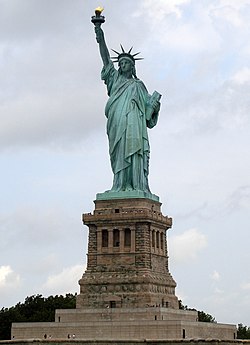objective facts
Statue of Liberty
The Statue of Liberty (Liberty Enlightening the World; French: La Liberté éclairant le monde) is a colossal neoclassical sculpture on Liberty Island in New York Harbor, designed by Frédéric Bartholdi and dedicated on October 28, 1886. The statue, a gift to the United States from the people of France, is of a robed female figure representing Libertas, the Roman goddess of freedom, who bears a torch and a tabula ansata (a tablet evoking the law) upon which is inscribed the date of the American Declaration of Independence, July 4, 1776. A broken chain lies at her feet. The statue has become an icon of freedom and of the United States.Bartholdi was inspired by French law professor and politician Édouard René de Laboulaye, who commented in 1865 that any monument raised to American independence would properly be a joint project of the French and American peoples. Due to the troubled political situation in France, work on the statue did not commence until the early 1870s. In 1875, Laboulaye proposed that the French finance the statue and the Americans provide the pedestal and the site. Bartholdi completed both the head and the torch-bearing arm before the statue was fully designed, and these pieces were exhibited for publicity at international expositions. The arm was displayed in New York's Madison Square Park from 1876 to 1882. Fundraising proved difficult, especially for the Americans, and by 1885 work on the pedestal was threatened due to lack of funds. Publisher Joseph Pulitzer of the World started a drive for donations to complete the project, and the campaign inspired over 120,000 contributors, most of whom gave less than a dollar. The statue was constructed in France, shipped overseas in crates, and assembled on the completed pedestal on what was then called Bedloe's Island. The statue's completion was marked by New York's first ticker-tape parade and a dedication ceremony presided over by President Grover Cleveland.
The statue was administered by the United States Lighthouse Board until 1901 and then by the Department of War; since 1933 it has been maintained by the National Park Service. The statue was closed for renovation for much of 1938. In the early 1980s, it was found to have deteriorated to such an extent that a major restoration was required. While the statue was closed from 1984 to 1986, the torch and a large part of the internal structure were replaced. After the September 11 attacks in 2001, it was closed for reasons of safety and security; the pedestal reopened in 2004 and the statue in 2009, with limits on the number of visitors allowed to ascend to the crown. The statue is scheduled to close for up to a year beginning on October 29, 2011, so that a secondary staircase and other safety features can be installed; Liberty Island and the concrete pedestal will remain open. Public access to the balcony surrounding the torch has been barred for safety reasons since 1916.

Subjective opinions
Solo As A Side Dish
I have had an ongoing correspondence with a ‘friend’ whom I’ve never met but feel I can call her ‘friend’ because we have been exchanging intimate, thoughtful, and fun conversations on the phone and through e-mail for a few years, and she continues to have an interesting professional trajectory. At one point, while doing document review, she was planning to go solo. During the planning and networking phase a truly fabulous legal job landed in her lap. (Yes, when you start acting like a peer instead of a subordinate, job opportunities surface!)
http://en.wikipedia.org/wiki/Statue_of_Liberty_________________________________________She took the job which offered opportunity, security, benefits and tremendous flexibility during her work week which dove-tailed very nicely with her life goals. Even with this economic turmoil she was also just promoted.When we corresponded last week she said she was really itching to practice the kind of law she wanted to practice in addition to her full time job. She saw starting her solo practice as a ‘side dish’, not the main course. This really got me to thinking about how often we tell people to hold onto their jobs until they can go solo as the ‘main dish’ never contemplating people may very well be happy with their current jobs but want to also have a ‘side dish’ practiceThere are some who would say you can’t have a solo practice as a side dish and do it effectively. They could be right if they saw the ‘side dish’ solo practice as just a stepping stone to becoming the ‘main course’ solo practice. However, this isn’t her goal. She just wants to take a few select cases when she chooses while maintaining her current job. I say, ‘why not?’In her particular situation, she is constantly approached about a very niched area of practice having to do with family formation catering to a particular ethnic group and sexual orientation. Couldn’t get nich-ier than that! It is also purely transactional and doesn’t require normal working hours or a court schedule. I personally believe this type of transactional work is best if you’re doing solo as a side dish.The nice thing about this approach is she will have a built in Plan B should her job somehow evaporate. But her goal isn’t to build her practice into a full time operation. Her goal is simply to have a solo practice in addition to her current full time job and on her terms representing just the people she wants to represent. There are no external pressures other than her desire to have a client base of her choosing in an area of law she is drawn to and will enjoy.
http://solopracticeuniversity.com/2011/02/14/solo-as-a-side-dish/

ไม่มีความคิดเห็น:
แสดงความคิดเห็น